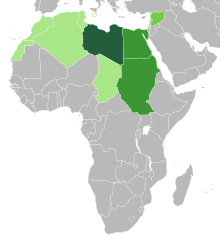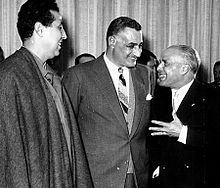Arab striving for unity
Arab striving for unity , the striving for unity ( wahda ) of the Arab fatherland ( watan ), is one of the main concerns of Arab nationalism or pan-Arabism , especially of its Nassist and Baathist representatives. The Libyan leader Muammar Gaddafi to go , numerous attempts to merge with other Arab states back. The variants range from the unification of the political leadership of two or three states to confederations and federations to a unitary state. Despite some dynastic aspects (until 1958), the striving for unity has above all an anti-colonialist character. In fact all projects failed due to the rivalries of their political leaders, in fact none was realized. Most projects barely got beyond the announcement of a proposal.
The high phase of this striving for unity lies between 1920 (first Pan-Syrian Congress ) and 1990 (unification of Yemen, but failure of the Libyan-Sudanese Union and the Iraqi annexation of Kuwait).
Temporary successful efforts
- 1958–1961 United Arab Republic (UAR): merger of Egypt and Syria in one union; the confederation of the Kingdom of North Yemen turns it into the United Arab States . Negotiations on the accession of revolutionary Iraq to the Union or the confederation fail in 1959.
- 1958 Arab Federation : on the other hand, the union of the Hashemite kingdoms of Iraq and Jordan as a counterweight to the UAR. Great Britain announces the handover of Kuwait to the Federation. It collapsed after barely six months in the revolution in Iraq.
Failed projects or suggestions
| Period | Project | Involved | target |
| 1946-1948 | Greater Syria | Jordan, Lebanon, Palestine, Syria | The unification plans of the Transjordan King Abdallah fail in the parliaments of Lebanon and Syria, but Jordan occupies parts of Palestine |
| 1943-1951 | Arab Union | Iraq, Syria (Greater Syria) | Plans by the Iraqi Prime Minister Nuri as-Said (1943) and Syrian putschists (1949) to annex Syria (and Jordan) to Iraq fail because of Syrian counter-coups |
| 1952-1956 | Unity of the Nile Valley | Egypt, Sudan | Egypt's claim to Anglo-Egyptian Sudan |
| 1960–1962 | Greater Morocco | Morocco, Mauritania, Algeria | 1960–1961 the Arab League supported the claim of the sultan or king in Rabat to the annexation of Mauritania to Morocco, which France refused. Morocco's claims to Algeria, however, were rejected by the Arab League from 1961 to 1962, but supported by France. |
| 1961 | United Iraq | Iraq, Kuwait | Great Britain and an inter-Arab security force prevent Kuwait from being annexed to Iraq, Kuwait becomes independent. |
| 1963 | United Arab Republic | Egypt, Iraq, Syria | Politico-military-economic federation between Egypt, Syria and Iraq, fails after a Nassist coup attempt in Syria |
| 1964-1966 | United Arab Republic | Egypt, Iraq | United political leadership for gradual economic, political and military integration, fails after Nassist coup attempts in Iraq |
| 1964-1967 | United Arab Republic | Egypt, North Yemen | United political leadership for gradual economic, political and military integration, Nasser rejects rapid union, but in fact North Yemen is under Egyptian control |
| 1964-1965 | Common Arab Market | Egypt, Iraq, Jordan, Syria | In 1965, Nasser warns that the Arabs would unite too quickly without prior economic integration, and Kuwait refrains from its planned accession |
| 1964-1970 | Union of the Arab Maghreb | Algeria, Libya, Morocco, Tunisia | economic integration, common market |
| 1965 | United Arab Republic | Egypt, Sharjah | Search of the Emir of Sharjah and Nasser for an alliance against Great Britain and Saudi Arabia |
| 1967-1968 | Unified state of the socialist Arabs | Egypt, Algeria, Iraq, Syria | The left-Baathist President Atassi's request to socialist-oriented regimes to unite with Syria fails with the right-Baathist coup in Iraq |
| 1968 | Federation of Arab Emirates | the later UAE, Qatar and Bahrain | economic, political and military alliance of the Gulf emirates against Saudi Arabia and Iran after the end of the British protectorate |
| 1969 | United Arab Republic | Egypt, Iraq, Syria | Syrian union plans with Egypt and other revolutionary states, Iraqi union plans with Syria and other Arab states, ultimately only Syrian-Iraqi military alliance |
| 1969-1970 | Revolutionary Arab Front | Egypt, Libya, Sudan | economic, political and military alliance as a preliminary stage of a later federation |
| 1971-1973 | Federation of Arab Republics | Egypt, Libya, Syria | economic, political, military and cultural alliance, as a precursor of a state within the same Egyptian-Libyan unit state planned |
| 1972 | Libyan-Maltese Federal Republic | Libya, Malta | economic, political and military alliance |
| 1972-1977 | Yemeni People's Republic | Yemeni Arab Republic (JAR), People's Democratic Republic of Yemen (VDRJ) | First attempt at "reunification" of North Yemen (JAR) and South Yemen (VDRJ) |
| 1972-1974 | United Arab Kingdom | Jordan, Palestine | Personal union as part of a peace with Israel, the proposal of the Jordanian king is rejected by the Palestinians, Israel and the Arab League |
| 1972 | United Arab Republic | Egypt, Iraq, Syria, PLO | The Iraqi union proposal collides with the FAR, hence the invitation to Iraq to join the federation |
| 1972-1974 | Arab Islamic Republic | Libya, Tunisia | 1972 Tunisia is invited to join the FAR, 1973 Tunisia's proposal for unification with Algeria and Libya, 1974 Libyan-Tunisian unitary state fails because of the Neo-Destur party |
| 1975-1976 | Supreme Political Command Council | Jordan, Syria | economic, political and military integration fails because Syrians turn back to Egypt |
| 1976-1977 | Federation of Arab Republics | Egypt, Sudan, Syria | United political leadership in preparation for a unified Egyptian-Syrian state within an Egyptian-Syrian-Sudanese federation fails because of Sadat's visit to Jerusalem |
| 1978-1979 | Charter of Joint National Action | Iraq, Syria | economic, political, military and ideological union of the two Ba'athist states fails due to Iraqi demands for the reunification of the Ba'ath party |
| 1979-1982 | Yemeni People's Republic | Yemeni Arab Republic (JAR), People's Democratic Republic of Yemen (VDRJ) | Second attempt at "reunification" of North Yemen (JAR) and South Yemen (VDRJ), common constitution |
| 1980 | Organic Union | Libya, Syria | Socialist unitary state fails due to Syrian military bureaucracy |
| 1981, 1983-84 | Jamahiriah | Libya, Chad | initially a plan for a union (1981), later a confederation (1983–1984) , fails due to French intervention, but until 1987 the northern half of Chad is de facto under Libyan control |
| 1982-1985 | Integral Union | Egypt, Sudan | economic, military and political ties fail because of the upheaval in Sudan |
| 1982-83, 1985-86 | Confederation of Arab States | Jordan, Palestine | The planned alliance fails because of the dispute over the form of government (federation or personal union) and the blockade of Israel |
| 1983 | Union of the Arab Maghreb | Algeria, Mauritania, Tunisia | economic and military alliance against Morocco |
| 1984-1986 | Arab-African Federation | Libya, Morocco | economic and political alliance against the Algerian-Mauritanian-Tunisian alliance fails because of Moroccan contacts with Israel |
| 1986-1987 | Arab Union | Libya, Sudan | economic and political ties fail because of Sudan's inner turmoil |
| 1987 | Arab Union | Algeria, Libya | economic and political ties fail due to Algerian concerns |
| 1988 | Confederation of Arab States | Libya, Palestine | economic and political alliance |
| 1988-1989 | United Arab Front | Iraq, Syria | Military alliance against Israel fails due to the Syrian-Iraqi conflict in the Lebanon conflict |
| 1989-1990 | Arab Cooperation Council | Egypt, Iraq, Jordan, North Yemen | economic and political alliance against the Gulf Cooperation Council, Syria does not join because of the Lebanon conflict, fails because of the Egyptian-Iraqi conflict in the Kuwait war |
| 1990-1991 | United Iraq | Iraq, Kuwait | Iraq occupies and annexes the " People's Republic of Kuwait ", the connection is not recognized internationally or under international law |
| 1990-1994 | Integral Union | Libya, Sudan | political, economic, military and ideological integration, invitation to Egypt (1990) and Iraq (1994) |
| 1991-1993 | Confederation of Arab States | Jordan, Palestine | joint delegation to the Madrid conference as a first step towards political and economic integration |
Only completed projects
- 1971 United Arab Emirates (UAE), excluding Qatar and Bahrain
- 1990 Yemen : North and South Yemen (1967, 1972/73, 1977 and 1980/81 unsuccessful attempts, 1994 attempt at secession)
Loose economic alliances
- 1945 Arab League : Egypt , Algeria (since 1962), Bahrain (since 1971), Djibouti (since 1977), Iraq , Yemen , Jordan , Qatar (since 1971), Comoros (since 1993), Kuwait (since 1961), Lebanon , Libya (since 1953), Morocco (since 1958), Mauritania (since 1973), Oman (since 1971), Palestine (since 1976), Saudi Arabia , Somalia (non-Arab country, since 1974), Sudan (since 1956) , Syria , Tunisia (since 1958), United Arab Emirates (since 1971)
- 1981 Gulf Cooperation Council (GCC): Saudi Arabia, Oman , UAE, Kuwait, Qatar, Bahrain
- 1989 Union of the (Great) Arab Maghreb (UAM): Libya, Morocco, Algeria, Tunisia and Mauritania
swell
- Günter Kettemann: Atlas for the history of Islam , pages 163–166 (Pan-Arabism: Pacts and mergers). Darmstadt 2001. ISBN 3534141180
- Lothar Rathmann (ed.): History of the Arabs - From the beginnings to the present , volumes 6 and 7th Akademie-Verlag Berlin 1983
- Günther Barthel (ed.): The Arab countries - an economic geographic representation . Haack Gotha 1987
- Johannes Berger, Friedemann Büttner and Bertold Spuler: Middle East PLOETZ - history of the Arab-Islamic world to look up . Freiburg / Würzburg 1987
Individual evidence
- ^ Lothar Rathmann : History of the Arabs, Volume 7, page 525. Berlin 1983
- ↑ Günther Barthel (Ed.): The Arab countries - An economic geographic representation, p. 11. Haack Gotha 1987
- ^ Lothar Rathmann : History of the Arabs, Volume 6, Page 185. Berlin 1983




